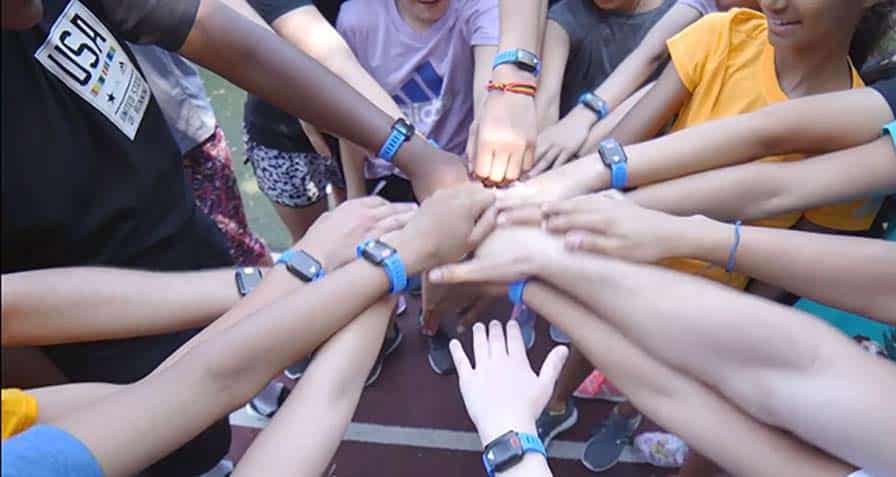Nov. 30, 2016
After three months of working with the IHT Zone heart rate monitors during his classes, physical educator Pedro Espinosa gave himself some important homework for the Thanksgiving school holiday. He vowed to add new heart rate data to each of his students’ records inside the IHT Spirit System in order to make each student’s PE experience more personalized.
 By utilizing each student’s resting (RHR) and max (MHR) heart rates along with gender, height and weight, Espinosa – and any teacher utilizing the IHT Spirit System – can assess student performance based solely on that student’s individual profile, bringing the national trend of personalized learning into PE.
By utilizing each student’s resting (RHR) and max (MHR) heart rates along with gender, height and weight, Espinosa – and any teacher utilizing the IHT Spirit System – can assess student performance based solely on that student’s individual profile, bringing the national trend of personalized learning into PE.
“We are to the point that we can make it personalized,” Espinosa said about his PE classes at IDEA Public School’s College Prep Alamo campus. “We started the year using the default [heart rate] settings. Everyone had the same heart rate goal. Now we can take that next step.”
The Bill and Melinda Gates Foundation explains personalized learning as “changing the learning environment so students can take more ownership of their learning and teachers can work with them to discover their passions and interests.”
Espinosa’s high school students have worn the IHT Zone wrist heart rate monitor during every PE class since September. The teachers have already noticed a drastic increase in the desire of students to meet their physical education goals.
Advantages of Personalized PE
“We want to make the goals more personalized, especially for the more athletic students who have to work harder to get into the yellow (moderate to vigorous physical activity) or red (vigorous activity) zone,” he said.
Goals that might push a high school athlete won’t necessarily work for students who are struggling with their fitness. “We also have kids who aren’t in great shape,” Espinosa said. “They get into the red very quickly.” Less-active students must work harder to perform more basic exercises, and their heart rates reach the “extremely vigorous activity” zone much more quickly.
Data increases student motivation
Through the Spirit System’s reporting, PE teachers can immediately email a performance report to students with their own specific workout data, which encourages them to work harder to achieve very personal results.
“Our students are already doing better than they were last semester,” Espinosa said. “I’ve seen a big difference. Kids are much more active. They are trying to be active, trying to move. Our activity time has doubled. I see a big change in their attitude towards exercise.”
“I’ve had these students since eighth grade and they are more motivated,” Espinosa said. “Their attitude has changed. They are checking their heart rates to make sure they are in the zone they need to be in.”
The data supports what Espinosa’s seeing. Heading into the Thanksgiving holiday break, Espinosa’s students have:
- spent nearly 64,000 minutes of class time exercising using the Zone monitors;
- reached the Yellow or Red Zones for 56% of those minutes (36,000 minutes);
- burned a combined 384,677 calories during 124 PE sessions (all classes).
IDEA’s PE Curriculum Manager Eren Kirksey, who spearheaded the effort to add IHT’s Spirit System to his network’s PE program, has also noticed the change.
“At the end of class, some of the students try to be the last in line to return the monitor,” Kirksey said. “They want to keep their heart rate high and in that optimal zone as much as they can.”
On Nov. 17, the Rio Grande Valley CBS affiliate, where IDEA’s Alamo campus is located, aired a feature about the school’s use of the Spirit System to combat area obesity. That same day, Espinosa praised one student who’s already making significant strides in a monthly assessment of the mile run.
“We have a ninth-grade boy who weighs 268 pounds,” Espinosa said. “Last year during the mile run, he ran it in 28 minutes. For his weight, all we really wanted him to do was finish it. This year, every time he’s run it, he’s run it faster. His last mile was 18 minutes.
“His progress is great, and you can see that in the way he acts,” Espinosa continued. “He’s happy now, and it’s obvious he’s getting more fit. Last year he was so sad and quiet.”
Personalized Assessments for Detailed Evaluation
While parents and students may feel that simply participating merits high grades in PE, teachers can now document how students are performing based on whether they meet goals.
“This makes it fair to everyone,” Espinosa said. “It gives us a way to grade based on the time a student spends in each zone compared to the goal.”
“For the first time, we have justified data on student achievement in PE,” Kirksey said. “There is real representation of student achievement. This is a new frontier for us.”
For us, that’s the pot of gold at the end of the rainbow: using the personal data to empower students to take charge of their fitness and well-being.
[turbo_widget widget-prefix=pw_call_to_action&obj-class=PW_Call_To_Action&widget-pw_call_to_action–text=%5Bbutton+href%3D%22ihtusa.com%2Fzone%22%5DIHT+Zone+Heart+Rate+Monitor+Demo%5B%2Fbutton%5D&widget-pw_call_to_action–button_text=]



